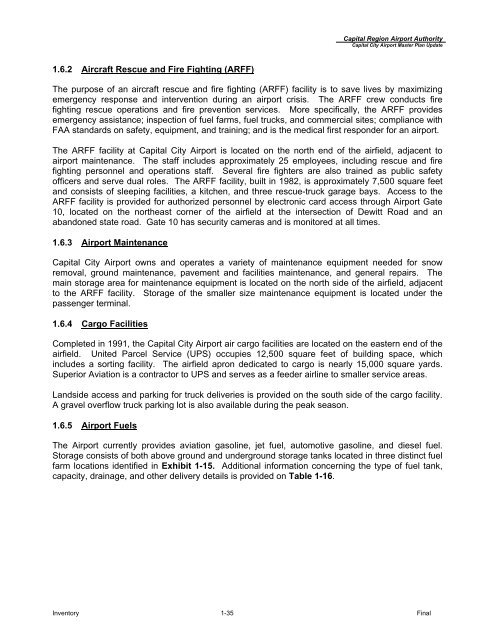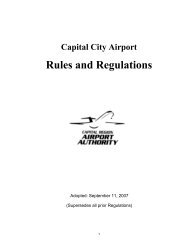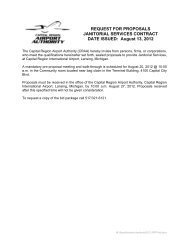Master Plan Update (pdf) - Lansing/Capital City Airport
Master Plan Update (pdf) - Lansing/Capital City Airport
Master Plan Update (pdf) - Lansing/Capital City Airport
You also want an ePaper? Increase the reach of your titles
YUMPU automatically turns print PDFs into web optimized ePapers that Google loves.
1.6.2 Aircraft Rescue and Fire Fighting (ARFF)<br />
<strong>Capital</strong> Region <strong>Airport</strong> Authority<br />
<strong>Capital</strong> <strong>City</strong> <strong>Airport</strong> <strong>Master</strong> <strong>Plan</strong> <strong>Update</strong><br />
The purpose of an aircraft rescue and fire fighting (ARFF) facility is to save lives by maximizing<br />
emergency response and intervention during an airport crisis. The ARFF crew conducts fire<br />
fighting rescue operations and fire prevention services. More specifically, the ARFF provides<br />
emergency assistance; inspection of fuel farms, fuel trucks, and commercial sites; compliance with<br />
FAA standards on safety, equipment, and training; and is the medical first responder for an airport.<br />
The ARFF facility at <strong>Capital</strong> <strong>City</strong> <strong>Airport</strong> is located on the north end of the airfield, adjacent to<br />
airport maintenance. The staff includes approximately 25 employees, including rescue and fire<br />
fighting personnel and operations staff. Several fire fighters are also trained as public safety<br />
officers and serve dual roles. The ARFF facility, built in 1982, is approximately 7,500 square feet<br />
and consists of sleeping facilities, a kitchen, and three rescue-truck garage bays. Access to the<br />
ARFF facility is provided for authorized personnel by electronic card access through <strong>Airport</strong> Gate<br />
10, located on the northeast corner of the airfield at the intersection of Dewitt Road and an<br />
abandoned state road. Gate 10 has security cameras and is monitored at all times.<br />
1.6.3 <strong>Airport</strong> Maintenance<br />
<strong>Capital</strong> <strong>City</strong> <strong>Airport</strong> owns and operates a variety of maintenance equipment needed for snow<br />
removal, ground maintenance, pavement and facilities maintenance, and general repairs. The<br />
main storage area for maintenance equipment is located on the north side of the airfield, adjacent<br />
to the ARFF facility. Storage of the smaller size maintenance equipment is located under the<br />
passenger terminal.<br />
1.6.4 Cargo Facilities<br />
Completed in 1991, the <strong>Capital</strong> <strong>City</strong> <strong>Airport</strong> air cargo facilities are located on the eastern end of the<br />
airfield. United Parcel Service (UPS) occupies 12,500 square feet of building space, which<br />
includes a sorting facility. The airfield apron dedicated to cargo is nearly 15,000 square yards.<br />
Superior Aviation is a contractor to UPS and serves as a feeder airline to smaller service areas.<br />
Landside access and parking for truck deliveries is provided on the south side of the cargo facility.<br />
A gravel overflow truck parking lot is also available during the peak season.<br />
1.6.5 <strong>Airport</strong> Fuels<br />
The <strong>Airport</strong> currently provides aviation gasoline, jet fuel, automotive gasoline, and diesel fuel.<br />
Storage consists of both above ground and underground storage tanks located in three distinct fuel<br />
farm locations identified in Exhibit 1-15. Additional information concerning the type of fuel tank,<br />
capacity, drainage, and other delivery details is provided on Table 1-16.<br />
Inventory 1-35 Final




